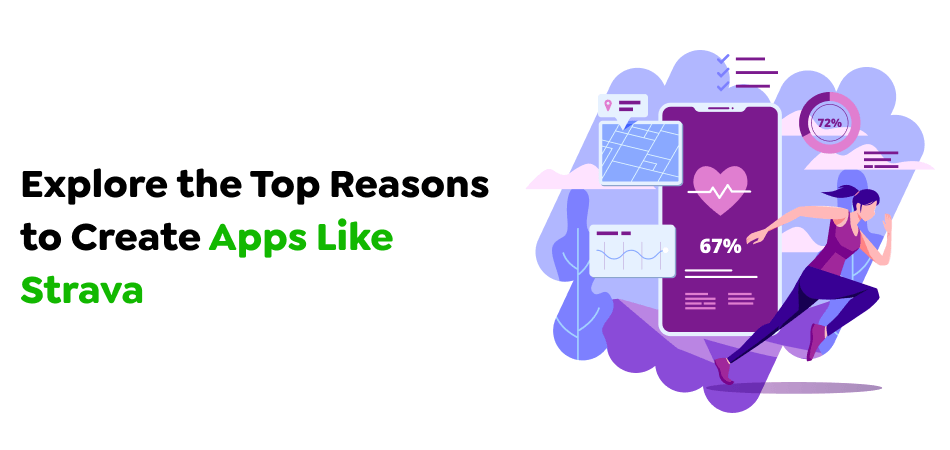29 Nov 2024
Updated on January 31st, 2025
How Much Does It Cost to Develop a Fitness App Like Strava?
Matthew Connor

Today, being healthy and fit has become the top priority of numerous people. Due to the growing popularity of fitness-related apps, users can follow their progress, set goals, and meet with other people with similar fitness goals. One app that has gained much attention recently is Strava. Strava has become a favorite app for fitness enthusiasts with its user-friendly interface and various options. This is why many business owners and entrepreneurs are trying to develop fitness apps like Strava. However, the issue remains the same: what is the cost of creating an app for fitness similar to Strava?
In this blog, we’ve compiled all the relevant information to give you the needed information.
What Is Strava?

Since its launch in 2009, Strava has evolved into a platform that combines health tracking, social media, and community development. All athletes, including cyclists, swimmers, and runners, can utilize Strava.
Strava is unique due to its focus on competition and friendship. Building Through participating in contests, joining groups, or keeping track of your friends is possible, you can build an identity and inspiration.
Strava is widely known as a tool that can make regular exercise enjoyable. By dividing routes into competition segments, Strava segments allow players to compete for the most efficient timings and top rankings.
Also Read : How to Build a Fitness App: A Step-by-Step Guide
Why is Strava App So Popular?
It’s easy to imagine that many business leaders need clarification on why Strava’s fitness app is gaining popularity. Strava’s appeal can be attributed to numerous motives that appeal to active and fitness-minded users alike.
1. Community and Social Features
Strava promotes a sense of belonging through the ability to connect with colleagues from the workplace, friends, and other fitness enthusiasts. Its social aspect encourages users to set goals and meet them while sharing their achievements with family and friends.
2. Data Tracking and Analytics
Strava provides in-depth analysis and data monitoring. Users can track their speed, distance, elevation, heart rate, etc. The app allows segment comparisons, which lets runners challenge each other and other runners on the same route.
3. Customizable Challenges
Strava is a fitness application that offers monthly challenges and competitions, encouraging users to challenge themselves and remain in the game.
4. Integration with Wearable Devices
Strava seamlessly integrates the most well-known wearable devices, such as watches and fitness trackers, enhancing users’ experiences.
5. Privacy Controls
Users are in control of the view of their activities. They can decide to keep the activity secret and also be able to share their activities with particular groups or the whole community.
There are five main reasons why Strava is very popular in the fitness market. Companies should absolutely look into the Strava fitness app and begin their business journey by using it correctly.
Also Read : The Ultimate Guide to Developing an App Like Duolingo
Market Statistics of Fitness Apps Like Strava App
It is evident that the fitness app market is expanding rapidly, and Strava is among the most prominent players in this sector. Here are some statistics for fitness apps that are on demand, like Strava:
- Market Size The market for fitness apps is expected to reach $15.7 billion by 2026, according to Statista.
- Growth Rate: According to Grand View Research, this market for fitness applications is expected to grow at a CAGR of 21.6 percent from 2021 to 2028.
- Earnings: According to Business of Apps, fitness apps generated $5.35 billion in revenue by 2021, an increase of 54% from the previous year.
- User: There were 385 million users exclusive to fitness apps in 2021, per the Business of Apps.
Strava has a long history of growth. By 2021, there were 1.8 billion users on Strava, an increase of 63% from 2020. Strava also has an enormous number of active users, with over 95 million users worldwide.
The fitness app market is competitive and overcrowded. However, Strava is highly positioned to succeed. It is a well-known branding name, has a loyal user base, and offers an extensive range of options. Strava has also invested in creating new markets and products and recently expanded to Latin America. Businesses operating in similar areas should look at Strava for app development with the assistance of the most trusted mobile app development company in Canada.
Also Read : How to Develop an App Like Shein: Understanding Costs and Features
Reasons to Create an App like Strava

This section will assist if you’re looking for an excuse to create apps like Strava.
We want to give you the most beneficial benefits that will surprise you. Take a look at them:
1. Increase Your Revenue
One of the most important reasons to create fitness apps is that this industry is growing and can earn you more cash than you imagine.
Using an app can provide a better user experience. Let them follow their fitness progress, change their habits, and share the information so your program will engage them. A well-designed fitness application is ideal for your business to generate profit.
2. Get a Competitive Edge
By analyzing your competition and the market, you will be aware of the people’s issues and the obstacles in the fitness industry.
This will allow you to create a distinctive USP for your application and increase the number of users who use it. It will also help you avoid any unprofessional fitness app design mistakes. If you show that your app is distinct, you’ll achieve a competitive edge and give your customers the best user experience.
3. Improved User Experience
Even the most inventive app only works with a good user experience.
By creating a fitness app designed to meet your user’s requirements and preferences, you can offer the top fitness apps to your clients, which will provide an outstanding experience.
The most important thing to do is to keep navigation accessible and feature-rich, which aligns with users’ needs and results in increased satisfaction and engagement.
4. Perfect Marketing Channel
A fitness app will help you increase the number of users you can target without emptying your wallet. If you’ve got apps, you can easily reach out to your users via promotions, deals, new services, and so on without spending much money.
It is also possible to send personalized messages via push notifications that direct them to a new product or guide them to relevant content within your app.
5. Build Brand Awareness
An app for fitness is an excellent method to increase awareness of your brand.
With captivating visuals that will draw people to join your app, grow your number of users, and establish your brand as an innovator in health and wellness.
The fitness app could go beyond being a fitness companion for users and become an avenue for promoting branding awareness. Amazing strategies can build an enduring user base.
These are a few of the most significant benefits you can get from your fitness and exercise application development.
Then, it’s time to include some of the most effective tools to ensure the success of your app quickly and easily.
Also Read : Unlocking Success: How to Develop a Tax Preparation App Like TurboTax
Must-Have Features In An App Like Strava

In the ever-changing market of fitness apps, the integration of essential functions is crucial to ensure the app’s durability. Find the most critical features to enhance Strava’s apps and improve the user experience and overall performance.
1. GPS Tracking for Real-Time Data
Incorporate powerful GPS tracking features. This is a crucial feature of any software for tracking activities, especially for activities that require lengthy distances. Similar to fitness apps like Strava, it provides users with live information regarding routes, speeds, and trajectories that can be displayed throughout the globe. Whichever application you’re working with, whether it’s apps designed to run for Android, iOS, or other platforms, GPS tracking is an essential feature that should not be overlooked.
2. Diverse Activity Tracking
Provide users with the capability to keep track of various sports and activities within the app. While Strava is focused solely on a specific sport, your application could be unique by allowing users to monitor different activities and provide information such as duration of time, total calories burned, and the athlete’s fitness level during their workout. Advanced analytics for certain sports will also aid users in enhancing their performance.
3. Calorie Burn Tracking
Integrating the log of calories burned into the Strava-like app you utilize to run is essential. While fitness apps often use this feature, boosting users’ confidence in it is vital. You might consider adding additional features like sleep tracking to give the users something unique and comprehensive that isn’t readily accessible.
4. Multi-Device Compatibility
Ensure your app is compatible with different devices and trackers to improve its user-friendliness. Although this could be difficult for people who choose to use DIY fitness apps, getting help from experts will help accelerate the process. Multi-device compatibility is a major advantage to programs that require the expertise of a professional.
5. Business Analytics for User Recommendations
Utilize the analytics feature to offer users personalized guidance to improve their fitness and other purposes. Utilize the data you gather to assist in creating your application by paying attention to the users. This will result in greater participation and a satisfying user experience. If you have apps closely related to cycling, Strava, which analyzes business or data, include it as an ideal idea.
Also Read : How to Develop an App Like Doximity: A Comprehensive Guide
Advantages of Creating an app like Strava
Below are some fundamental benefits of making a Fitness social network application like Strava.
1. Super Unique Selling Proposition
They are entirely suitable for GPS trackers, the most recent mobiles and devices. The integration of social media platforms can make it more enjoyable to use. With a clearly defined value proposition, you can make your mark beneficially.
Strava is a social network that lets users participate in regular cycling, jogging, and hiking tracks. Users can then compare Strava to other similar apps across the globe. Many different apps like strava are available on the market; however, none of them attract the user base that Strava does.
The primary reason for the app’s success is its USP. Strava provides every item to the user and makes them feel part of the application. With just a small change in behavior, Strava has created an ideal consumer base in the marketplace.
2. Easy to Track
Users can monitor and evaluate their week’s performance to encourage them to work harder. In addition to tracking, athletes may also post their progress on the social network to inform others about their training.
These features are fantastic for the User Experience. If they are well-designed, the app could be a massive success. Users often require a way to monitor their fitness and health without delay. Strava aids them in keeping track of their health and wellness with a simple procedure.
This feature, the User Interface, has maximum potential since users interact with the application for various reasons. The app can be used to do anything and check their fitness status. Developing apps like Strava incorporates this feature since it takes the app’s capabilities to a higher level.
3. Freemium Model
Utilizing the model of freemium apps gathers both user and return on investment. The model allows users to access the app at no cost, but they can purchase it if they require more features. Users can switch easily to empty.
Emptors are those who use your app by becoming active members. They first get to try the app, evaluate its value, and willfully pay for it. This is the best method to build a sense of trust between your customers.
Freemium is not just about helping users but also the app’s owner. Numerous users use your app for free, and premium features are promoted. Inspiring features can convince people to pay for the privilege and enjoy the best experience for users.
4. More Engaging than Typical Applications for Fitness
Fitness apps that align with social apps draw users in more ways than just exercising. Users can use the app more frequently. Their engagement will rise since they are likely to talk about it and interact with others via the health platform.
Users love discussing their achievements and often share how to be a part of the world. Stories of transformation may be able to find a place. This feature enhances the utility as users discover a place to integrate and interact.
By utilizing this function, you can attract users of fitness apps and some of the users on your social media accounts by enhancing the features available on the User Interface to encourage more interaction and higher revenue.
Also Read : Transforming Healthcare: How to Build an App Like GoodRx
Challenges in Developing an App Like Strava
It’s essential to be aware of the issues you might face ahead of time so you are prepared. Here are a few issues you’ll need to face when developing apps like Strava:
1. Data Accuracy
Integration with wearables is challenging in terms of data accuracy. There will be times when the GPS signal isn’t reliable or available or when the device’s batteries are depleted.
2. Data Security
It is crucial to protect your user’s personal health information from unauthorized access by anyone who is not authorized. This can be accomplished easily through biometric authentication and multi-factor authentication.
Additionally, you have to adhere to the applicable rules related to data privacy, which include GDPR and GDPR. With the numerous fitness apps on the market and the competition for users, keeping them interested in your application can take time and effort. Features that facilitate games, social interaction, and personalized feedback and rewards can be a great way to keep users interested.
Also Read : How Much Will It Cost to Create an AI-Based Shopping App Like Target?
Cost of Building a Fitness App Like Strava

Regarding the costs involved in creating an app for fitness, such as Strava, the price can differ depending on various factors. A few of them are as follows:
1. Registration of Profiles for Users:
Profiles similar to those of a social networking platform like a fitness application, Strava, require users to create profiles and sign up to access the features. The cost for setting up this feature is the development of a user-friendly interface for managing databases and the creation of a secure login system.
2. Activity Tracking:
One of the most significant features offered through Strava is its activity tracking feature, which uses GPS to monitor the user’s activity, including running, cycling, or swimming. It requires integration with Google Maps or other mapping services, which may increase the development cost.
3. Social Features:
Strava’s popularity is due to its ability to connect users and create the feeling of belonging to a community. If you plan to create an app similar to Strava’s Fitness, you’ll need to include elements like leaderboards, group competitions, and the ability to connect to other members and keep track of them. These features can increase the cost of creating an application.
4. Push Notification:
Push notifications may change fitness apps. They can aid users in staying active and motivated with timely reminders, updates, and even accomplishments. However, implementing this feature may increase the cost of development.
5. User Experience and Design:
An attractive and user-friendly layout is essential to creating any app. In the case of fitness apps like Strava, it’s important to design an attractive, user-friendly, and intuitive interface. This could significantly impact the development costs.
Creating a fitness app can cost from $15,000 to $50,000. However, it can be more expensive when the app has advanced features.
Also Read : How Much Does It Cost to Develop an App in 2025? A Comprehensive Guide
Tech-Stack to Build a Fitness App Like Strava
If you are developing a fitness app such as Strava with the help of a fitness app development company, you need an understanding of the technology stack and the appropriate platforms and tools to ensure the app’s success. Here’s an overview of Strava’s technology stack as well as recommended tools for developing:
1. Mobile App Platforms
To develop a fitness app, you’ll need to select between two operating systems: iOS (Apple) and Android (Google). This will affect the technology stack.
2. Programming Languages
Swift and Objective-C are the most used languages for iOS. Kotlin is recommended for Android, but Java can be used as an alternative.
3. Backend Development
- Server: Node.js, Ruby on Rails, Python, or Java are the most well-known alternatives for creating backends.
- Databases: Utilize databases like MySQL, PostgreSQL, or NoSQL databases (MongoDB) to keep information about users and fitness data.
4. Front End Development Frameworks
You can use popular frontend frameworks like React or Angular to create web-based components for your app.
- Cloud Services: To get stable, high-performance hosting, utilize cloud-based services such as Amazon Web Services (AWS ) or Google Cloud Platform (GCP).
- APIs: You’ll need to connect to APIs that give information on the location (e.g., Google Maps API) and may be associated with fitness (e.g., wearable devices, such as Fitbit ).
Also Read : Unlock the Future of Finance: How to Develop a Neobanking App Like SoFi
Future of Fitness Apps
In the near future, towards the future of fitness apps, the next generation of apps is expected to bring even greater innovation and integration thanks to advances in AI and the IoT as well as immersive technologies such as VR, AR, and AR. Let’s look into the next steps for fitness applications and discover how to create a fitness application that stands out in the marketplace.
1. AI-Personalized Recommendations
AI is revolutionizing fitness apps by providing highly customized workout and nutrition plans. AI algorithms analyze user information—such as weight, age, fitness levels, and health objectives—to provide personalized suggestions.
For example, MyFitnessPal has integrated AI to provide workouts and meal programs that adjust to users’ needs and personal preferences. This fitness app’s business model has helped it attract more than 100 million customers.
2. Connectivity and IoT
Future fitness apps and fitness apps for homes are driven by high-tech connected equipment, such as smart mats and exercise machines that provide real-time information, customized feedback, and interactive exercises. Equipment like treadmills and stationary bicycles now integrates with apps to tailor workouts and monitor progress. Smart mats give immediate feedback on form and posture. IoT technology in the fitness industry increases the effectiveness of workouts and produces exciting fitness experiences for home use.
Fitness apps use advanced technology to seamlessly integrate various devices, providing live data and personal insights.
For example, Peloton and NordicTrack’s connected machines permit customers to take advantage of online and live fitness sessions, seamlessly integrating performance metrics into their workout routines.
3. Gamification and Social Features
Social and gaming features are two popular fitness app ideas for increasing users’ involvement and motivation. The fitness apps of the future will add game-like elements like challenges, leaderboards, rewards, and leaderboards, along with social sharing features, to give users an engaging experience.
Strava’s 2024 Year of Sport, Its Trend Report indicates that over 50% of Strava’s users draw their motivation from family or friends who exercise. 77% of Generation Z athletes feel a greater sense of belonging after watching their family and friends’ events via Strava.
4. VR and AR Workouts
Immersive technologies such as VR and AR are set to change fitness by making exercises more enjoyable. These technologies simulate a variety of scenarios and environments, from cycling in virtual landscapes to engaging AR meditation sessions that you can enjoy in your home.
AR and VR workout applications transform conventional exercises into engaging and stimulating VR environments.
For instance, Supernatural, a VR application for fitness and meditation, allows users to exercise, stretch, and meditate in breathtaking virtual worlds accompanied by actual trainers.
5. Preventive Healthcare
Health and fitness apps tend to focus on preventive health, using data analytics to detect possible health risks and provide prompt intervention. By monitoring various health indicators, such as blood pressure, these apps identify issues and recommend preventive measures, such as changing lifestyles or seeking medical attention.
Apps such as Fitbit and Garmin keep track of physical activity and monitor the variability of heart rate and sleep patterns, offering insights on overall health and possible issues to be aware of.
Conclusion
Since the best fitness programs continue to make huge profits, developing apps like Strava might be wise.
However, creating an excellent fitness application is complex and requires much creativity. It should be unique with all the needed features and run efficiently.
Development costs also matter. In addition, adding particular features will result in higher costs. If you have a limited budget, the best option is to create the minimum acceptable app (MVP) initially. If the app is successful, more features could be added.
Fitness apps can be great investments in terms of earning money and self-gratification. So, don’t give up. Take your time and follow the basics of developing fitness apps.
Get in touch with Techugo today to turn your fitness app idea into reality!
Get In touch
We are excited to here from you and let’s start something special Together. Call Us for any inquiry.
Write us
sales@techugo.caJust a call away
About you




